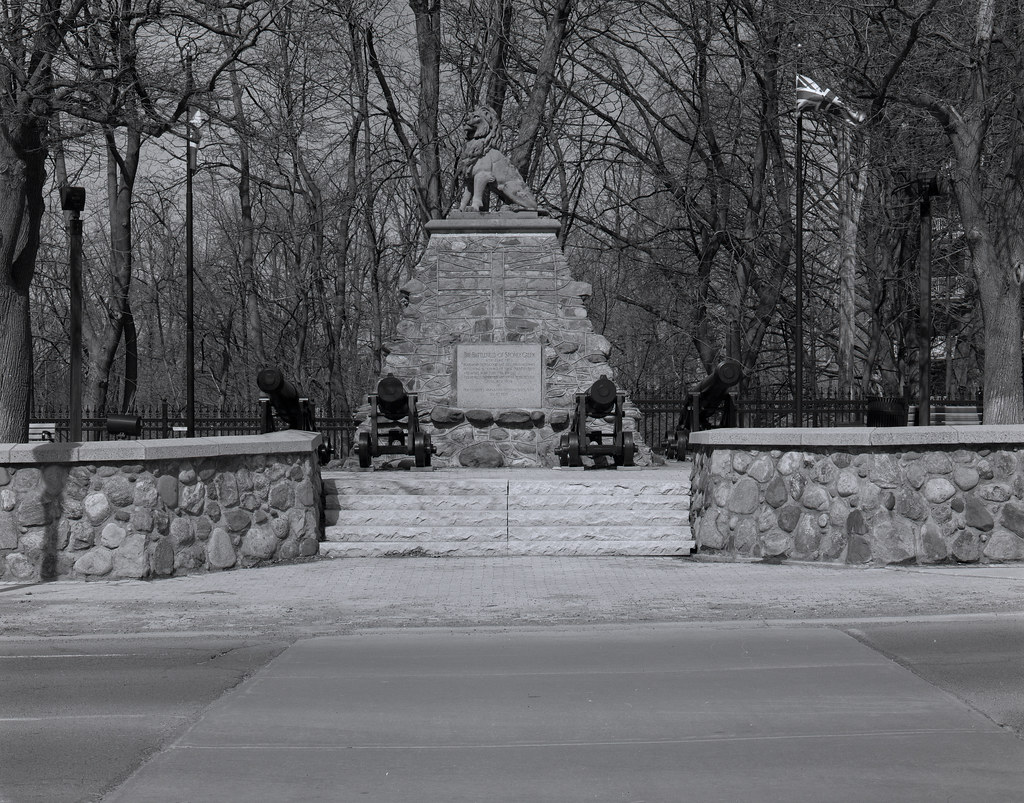The term Burlington Heights is a misnomer, as the Heights are technically located in Hamilton. But during the Anglo-American War of 1812, Burlington Heights became home to an often forgotten fort. Burlington Heights started life as a simple farm owned by Richard Besley. When the Americans invaded and captured the Niagara Region in May 1813 and forced the full retreat of the British Army of the Center, they would establish an armed camp at Burlington Heights, today located at the border of Hamilton, Ontario and Burlington, Ontario. It would start as a simple structure with field fortifications to provide a rallying point for the British Army and hold against the Americans should they attempt to penetrate further into Upper Canada.

Canon AE-1 Program – Canon Lens FD 50mm 1:1.4 – Fuji Neopan Acros 100 @ ASA-100 – Kodak Xtol (Stock) 8:00 @ 20C
Burlington Heights would be under the command of General John Vincent for the first part of the war, under his direction, field fortifications gave way to earthworks, casemates to store arms and ammunition, blockhouses and barracks to shelter the troops stationed there. Artillery batteries to fire on potential attackers and more importantly facing out onto Burlington Bay. Burlington Heights would sit out the war as more a jumping-off point. Mostly because, despite the size and importance of the site, Vincent suffered from a lack of troops and supplies. He also knew that should the Americans attempt to invade and lay siege; he would be certain to fall and be forced to retreat to York (Toronto) or Kingston. Vincent’s only saving grace would be the cautious movements of the American commander, General Henry Dearborn.

Nikon D70s + Sigma DC 18-50mm 1:2.8 EX MACRO
While Burlington Heights never saw a direct attack during the war, that doesn’t mean it didn’t play a part. It was from here that Lieutenant-Colonel John Harvey launched his moderately successful night assault against the Americans camped at Stoney Creek. And while the battle was not a straightforward victory for the British, it certainly resulted in the Americans withdrawing allowing for their defeat at Beaver Dams. The artillery batteries would see action during the Naval engagement known as the Burlington Races to defend the Naval Squadron of Commodore James Lucas Yao against the American Squadron of Commodore Isaac Chancy preventing their capture. The Heights served a darker purpose serving as the final prison for seven men charged with treason during the Bloody Assizes, and they were hanged on the Heights.

Pacemaker Crown Graphic – Schneider-Kreuznach Symmar-S 1:5.6/210 – Kodak Plus-X Pan (PXP) – Kodak Microdol-X (Stock) 8:00 @ 20C
By the end of the war, the need for an army post at Burlington Heights ended and the fort was abandoned by 1815. Richard Besley would return to his farm, but financial difficulties followed him, and he soon found himself needing to offload the property to pay his debts. In 1832 he sold the land to a former British Officer and up-and-coming Lawyer in Hamilton Allan MacNab. MacNab had a love of all things military and had served in both the militia and regular army during the war. However, a cholera outbreak in 1832 forced the use of the old fort as a quarantine hospital. MacNab would use several of the old casemates and the foundations of the Beasley House to construct his own grand home, Dundurn Castle seeing completion in 1835. Other parts of the military fort would become the Hamilton Cemetary in 1847 and the Royal Botanical Gardens in 1932. Further sections would be sold off the Great Western Railway in the 1850s to be used as their main rail yard and headquarters.

Rolleiflex 2.8F – Carl Zeiss Planar 80mm 1:2.8 – JCH Streetpan 400 @ ASA-400 – Blazinal (1+25) 10:30 @ 20C
Today there is still plenty of see of Burlington Heights. Dundurn Castle still stands, it was sold off at MacNab’s death, serving first as an institute for the Deaf and Mute before purchasing by Donald McInnis in 1872. McInnis would see the property in 1899 to the City of Hamilton who restored it in 1960 and today it is a living history museum standing as Dundurn would have in the 1850s at the height of MacNab’s power. The military casemates are still visible in the home’s basement. Plaques and cannons dot the shoreline marking the different points of the Earthworks. Several examples of Earthworks are still visible in the Hamilton Cemetary and Royal Botanical Gardens in the Rock Garden. Additionally, you can see more artefacts from the Military Post at the Hamilton Military Museum on the Dundurn property including contemporary illustrations of what the fort would have looked like during the War.

Contax G2 – Carl Zeiss Biogon 28/2,8 T* – Rollei RPX 25 @ ASA-25 – Kodak D-76 (1+1) 8:00 @ 20C
Written with Files from:
Guidebook to the Historic Sites of the War of 1812 Second Edition by Gilbert Collins – 2006 The Dundurn Group Publishers
Elliott, James, and Nicko Elliott. Strange Fatality: The Battle of Stoney Creek, 1813. Montréal: Robin Brass Studio, 2009. Print.
Lossing, Benson John. The Pictorial Field-book of the War of 1812 Volume 2. Gretna, LA: Pelican Pub., 2003. Print.